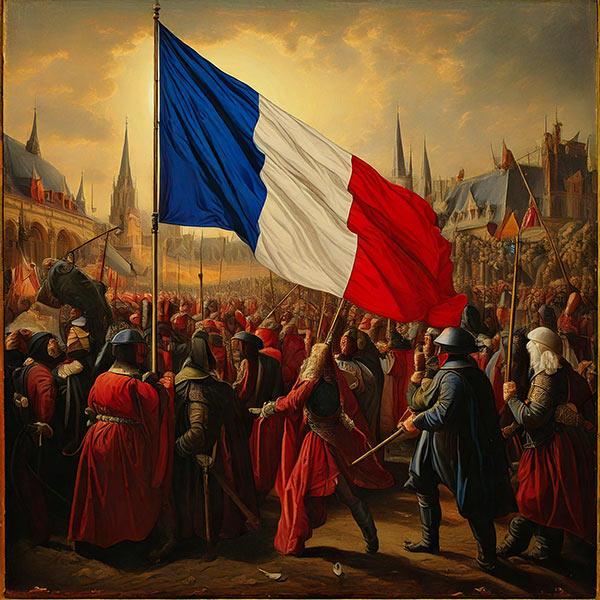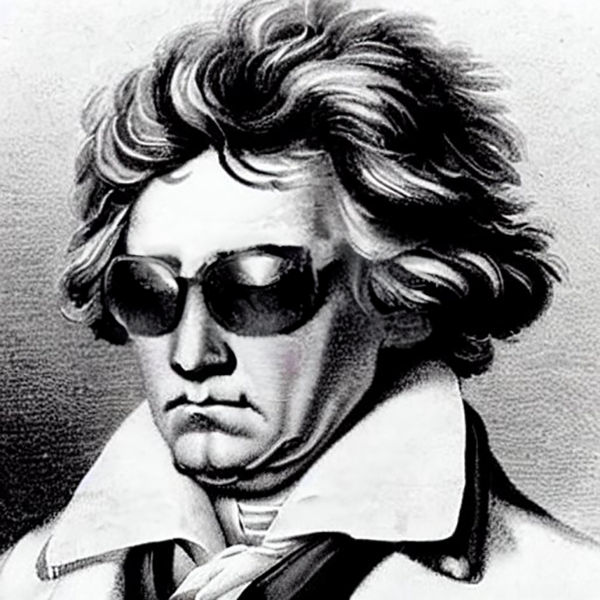Like his piano sonatas, Ludwig van Beethoven’s symphonies stand as towering achievements in the world of classical music. Composed between 1800 and 1824, these nine masterpieces mark a significant evolution in the genre, pushing the boundaries of what symphonic music could convey. Beethoven’s ability to blend emotional depth, technical innovation, and sheer musical power allowed him to transform the symphony from a formalized structure into a deeply expressive art form. Each of his symphonies reflects his unique voice, from the heroic and dramatic tones of the “Eroica” to the universal message of joy and brotherhood in the “Choral” Symphony.
Beethoven’s symphonies are celebrated not only for their melodic and harmonic richness but also for their groundbreaking structures and orchestration. He expanded the scope of the symphonic form, introducing new instruments, experimenting with unexpected transitions, and uniting movements in innovative ways. This revolutionary approach set a new standard, influencing generations of composers who followed.
Today, Beethoven’s symphonies remain cornerstones of the orchestral repertoire, studied by musicians, analyzed by scholars, and adored by audiences worldwide. Their enduring appeal lies in their ability to convey a vast range of human emotions, from triumph and despair to hope and joy. This guide will delve into each of these symphonies, exploring their unique qualities, historical context, and the lasting legacy that has cemented Beethoven’s place as one of the greatest symphonic composers of all time.
How Many Symphonies Did Beethoven Compose?
How many symphonies did Beethoven write in his lifetime? Ludwig van Beethoven composed a total of 9 symphonies throughout his lifetime. These works stand as some of the most significant achievements in classical music, each reflecting his evolving style and the shift from the Classical era to the Romantic era.
The question remains: How many symphonies did Beethoven complete?
Beethoven completed all 9 of his symphonies, making them some of the most celebrated and fully realized works in the classical repertoire. Unlike other composers such as Schubert or Mahler, who left behind unfinished symphonies, Beethoven did not have any partially composed symphonies that survived.
While he explored and sketched ideas for a 10th Symphony late in his life, these sketches were never developed into a full, complete work. Thus, the 9 symphonies he completed are considered his definitive contributions to the symphonic genre, each a testament to his creative vision and ability to push the boundaries of music during his time. So, if you ask “How many Beethoven symphonies are there?” – it’s definitely 9, not 10.
Beethoven’s Symphonies Across Different Periods Beethoven’s 9 symphonies were composed over three distinct periods of his life, often categorized as the Early, Middle, and Late periods:
- Early Period (1799–1802) – During this phase, Beethoven’s style was heavily influenced by Classical traditions, similar to the works of Haydn and Mozart. His Symphony No. 1 and Symphony No. 2 fall under this period, characterized by elegant, structured compositions with hints of his own emerging voice.
- Middle Period (1803–1812) – Known as his “Heroic” period, this phase marked a shift toward more dramatic, expressive compositions. It includes some of his most famous works, such as Symphony No. 3 (Eroica), which broke traditional forms, and Symphony No. 5, with its iconic, fate-like opening motif.
- Late Period (1813–1824) – During this time, Beethoven’s music became more complex, emotional, and introspective. His Symphony No. 9 (Choral Symphony), which introduced vocal soloists and a choir in the final movement, was a revolutionary piece that encapsulated his creative genius even as he struggled with complete deafness.
Symphony No. 1: Classical Beginnings
With which symphony did Beethoven begin to expand the possibilities of the genre?
Symphony No. 1 marked the beginning of Beethoven’s symphonic journey. While it largely adhered to the classical forms and styles established by Haydn and Mozart, it also contained subtle innovations that hinted at Beethoven’s future impact on the genre.
Though rooted in the classical tradition, Symphony No. 1 displayed a few features that were unusual for the time. For instance, it began with a slow introduction that ventured through unexpected harmonic shifts, a decision that set the stage for an intriguing and playful first movement. This was a slight yet noticeable deviation from the more straightforward structures his predecessors employed.
Moreover, Beethoven was already experimenting with orchestral color and dynamics, subtly hinting at his desire to break away from the norm. The symphony’s final movement begins with a surprising sequence of notes that almost seem like a musical joke, starting with a quiet, slow scale before bursting into a lively, fast-paced conclusion. This playful touch was an early indication of Beethoven’s approach to symphonic form—one that combined traditional structures with a sense of drama and surprise.
Thus, Symphony No. 1 not only marked the start of Beethoven’s journey but also subtly expanded the possibilities of the genre. It set the stage for the greater transformations he would bring to the symphonic form in the years to follow.
Symphony No. 3 “Eroica”: A Turning Point
Which symphony did Beethoven initially dedicate to Napoleon Bonaparte?
Beethoven originally dedicated Symphony No. 3 in E-flat Major, Op. 55, also known as the “Eroica,” to Napoleon Bonaparte. At the time, Beethoven admired Napoleon as a symbol of freedom and democracy, embodying the ideals of the French Revolution. Inspired by these ideals, he sought to honor Napoleon by dedicating the symphony to him.

However, this dedication was eventually withdrawn. When Napoleon declared himself Emperor in 1804, Beethoven was deeply disappointed and felt betrayed, as he had seen Napoleon’s rise as a beacon of liberty and change. Upon hearing the news, Beethoven furiously tore up the title page that bore the dedication to Napoleon. He later remarked, “So he is no more than a common mortal! Now, too, he will tread underfoot all the rights of man, indulge only his ambition; now he will think himself superior to all men, and become a tyrant!” The symphony was instead renamed “Eroica,” meaning “heroic,” with a new dedication that read: “To the memory of a great man.”
How “Eroica” Changed the Symphony Forever
Symphony No. 3 was a groundbreaking work that fundamentally changed the way symphonies were perceived and composed. Before “Eroica,” symphonies typically followed a four-movement structure, with each movement being relatively concise and adhering to classical norms. Beethoven shattered these conventions with “Eroica,” creating a symphony that was almost twice as long as those of his predecessors, with a scope and emotional range that had never been heard before.
The first movement alone is an epic piece, characterized by its bold and assertive theme. It explores a wide variety of emotions, shifting from heroic to tragic to triumphant, challenging listeners with its complexity and length. The second movement, a funeral march, adds a sense of profound depth and somber reflection, making it one of the most moving movements Beethoven ever composed. It was this movement that demonstrated his ability to convey deep, human emotions through music, setting a new standard for what a symphony could express.
Another innovation was Beethoven’s connection between movements. For instance, he incorporated symphonic continuity, where thematic material from one movement would be subtly referenced or developed in others, giving the symphony a cohesive, unified feel.
The “Eroica” symphony also expanded the scope of orchestration, with Beethoven using the orchestra in novel ways, experimenting with dynamics, and pushing the instruments to new expressive limits. It was a symphony that told a story, not just through melodies, but through the sheer force of its musical architecture. This was not just music to be heard; it was music to be experienced.
By dramatically expanding the length, structure, and expressive range of the traditional symphonic form, “Eroica” set a new standard for the genre. It redefined what a symphony could be, influencing countless composers who followed, and marking a true turning point in Beethoven’s career as well as in the history of classical music.
Symphony No. 5: The Iconic Four-Note Motif
How did Beethoven describe the opening motive of his Symphony No. 5 in C Minor, Op. 67?
Beethoven famously characterized the opening motif of his Symphony No. 5 with the phrase “Fate knocking at the door.” This vivid description encapsulates the urgency and intensity of the symphony’s first movement. The four-note motif—comprising three short notes followed by a longer one—creates an immediate sense of drama and tension. Beethoven’s ability to convey such profound emotion through this simple yet powerful phrase has made it one of the most recognizable and celebrated motifs in classical music history.
Why is this motif so famous, and how does it represent the symphony’s theme?
The four-note motif is not just famous for its memorable sound; it embodies the overarching themes of struggle and triumph that permeate the entire symphony. This motif appears in various forms throughout the piece, serving as a musical representation of fate and the human condition. Its repetitive nature reflects the relentless challenges that life presents, while the dynamic contrasts between the notes evoke feelings of tension and release. As a result, the motif transcends mere musicality, becoming a symbol of resilience and perseverance. Its inclusion in popular culture—from films to advertisements—further solidifies its status as an iconic representation of Beethoven’s genius.
How does Beethoven connect the third and fourth movements of his Fifth Symphony?
One of the most innovative aspects of Beethoven’s Fifth Symphony is the seamless transition between the third and fourth movements. Typically, symphonic movements are separated by distinct pauses; however, Beethoven cleverly intertwines the scherzo and the finale, creating an uninterrupted flow of music. This transition is achieved through the use of the same thematic material that appears in both movements. As the scherzo concludes, the final movement bursts forth without a break, energizing the listener and heightening the dramatic impact. This innovative technique not only showcases Beethoven’s mastery of form but also emphasizes the overarching narrative of struggle leading to triumph.
Which one of the following examples comes from a famous Beethoven symphony?
Beethoven’s symphonies are replete with recognizable motifs, but none are as iconic as the four-note theme of Symphony No. 5. This motif has become synonymous with Beethoven’s style, representing the epitome of his ability to blend emotion with musical structure. The universality of this motif allows it to resonate across cultures and generations, cementing Beethoven’s legacy as a revolutionary composer. Its frequent appearances in various media—from film scores to commercials—underscore its impact and the way it encapsulates the essence of Beethoven’s work: a profound exploration of the human experience.
Symphony No. 6 “Pastoral”: Beethoven’s Nature Symphony
What is the nickname of this symphony by Beethoven?
Beethoven’s Symphony No. 6 is affectionately known as the “Pastoral” Symphony. Composed in 1808, this symphony marks a significant departure from the more dramatic and intense themes typically found in classical symphonic works. The nickname “Pastoral” reflects Beethoven’s intention to evoke the serene beauty of the countryside, creating a musical landscape that invites listeners to experience the tranquility and charm of nature.

How does this symphony depict nature and stand out from traditional symphonic themes?
The “Pastoral” Symphony is a vivid representation of Beethoven’s deep appreciation for nature. Unlike traditional symphonies that often focus on abstract themes of heroism or struggle, the “Pastoral” emphasizes the beauty and serenity of rural life. Each movement serves as a musical tableau, capturing different aspects of the natural world.
- Movement One: Awakening of Cheerful Feelings Upon Arrival in the Country
This movement introduces listeners to a peaceful countryside scene, characterized by gentle melodies and flowing rhythms. The use of woodwinds and strings creates an idyllic soundscape, immersing the audience in the beauty of nature. - Movement Two: Scene by the Brook
Here, Beethoven paints an auditory picture of a bubbling brook, utilizing flowing musical lines to mimic the sound of water. The delicate interplay of instruments evokes a sense of tranquility and calm, allowing listeners to envision themselves in a serene natural setting. - Movement Three: Merry Gathering of Country Folk
This lively movement captures the essence of rural festivities. With its dance-like quality and joyful melodies, Beethoven reflects the carefree spirit of country life. The lively rhythms create a sense of community and celebration among the characters depicted in the music. - Movement Four: Thunderstorm
The fourth movement contrasts sharply with the previous ones, as Beethoven portrays a sudden thunderstorm. The dramatic shifts in dynamics and orchestration convey the power and ferocity of nature, showcasing Beethoven’s ability to evoke a range of emotions through music. - Movement Five: Shepherd’s Song: Happy and Grateful Feelings After the Storm
The symphony concludes with a serene and uplifting finale, reflecting gratitude for the calm that follows the storm. This movement encapsulates the essence of the “Pastoral” Symphony, emphasizing harmony and peace in the natural world.
Through these movements, Beethoven not only celebrates nature but also communicates a profound connection to the environment. The “Pastoral” Symphony stands out in the classical canon for its ability to transport listeners into the heart of nature, showcasing Beethoven’s innovative approach to symphonic composition. This work invites audiences to appreciate the beauty and tranquility of the countryside, making it a timeless masterpiece that resonates with nature lovers and music enthusiasts alike.
Symphony No. 9 “Choral”: A Masterpiece of Unity
Which work by Beethoven is called the Choral Symphony?
Beethoven’s Symphony No. 9 is often referred to as the “Choral” Symphony. This title reflects the groundbreaking inclusion of vocal soloists and a full choir in the final movement, a departure from the purely instrumental traditions of earlier symphonies. The Ninth Symphony stands as a monumental achievement in classical music, merging symphonic and choral elements to create a powerful expression of unity and humanity.
Why did Beethoven write Symphony No. 9?
Beethoven composed Symphony No. 9 as a musical setting for Friedrich Schiller’s famous poem “Ode to Joy.” Completed in 1824, the symphony encapsulates the ideals of universal brotherhood and human connection. In the final movement, the choral setting of “Ode to Joy” serves as a powerful anthem, celebrating the bond among all people. Beethoven’s choice to set this text to music highlights his vision of a world united in joy and harmony, transcending borders and differences. The symphony has since become a timeless representation of hope and unity, inspiring countless movements for peace and social justice.
When did Beethoven write his 9th Symphony?
Beethoven composed his Ninth Symphony between 1822 and 1824. This period was marked by Beethoven’s increasing deafness, yet he continued to innovate and push the boundaries of music. The Ninth Symphony showcases his remarkable ability to convey profound emotions and complex ideas, even in the face of personal challenges. The lengthy process of composition reflects Beethoven’s dedication to creating a work of lasting significance, culminating in a symphony that remains a cornerstone of the classical repertoire.
A movement from which Beethoven symphony was selected to celebrate the fall of the Berlin Wall?
The final movement of Symphony No. 9, featuring the “Ode to Joy,” was chosen to commemorate the fall of the Berlin Wall in 1989. This historic event marked a significant moment in the quest for freedom and unity in Germany and beyond. The anthem’s powerful message of brotherhood resonated deeply during the celebrations, symbolizing hope and the triumph of the human spirit over division and oppression. The choice of this movement underscores its universal appeal and enduring relevance in moments of social and political change.
Which symphony by Beethoven has become a rallying cry for widely divergent philosophies?
Symphony No. 9 has evolved into a rallying cry for various philosophies and movements advocating for freedom and unity. Its message of universal brotherhood, encapsulated in the “Ode to Joy,” has been embraced by diverse groups, from civil rights activists to political movements. The symphony’s ability to transcend cultural and ideological boundaries speaks to its power as a work of art. It has been adopted in numerous contexts, symbolizing the collective aspirations of humanity for peace, freedom, and unity, making it one of Beethoven’s most celebrated and influential compositions.
Expanding the Genre: Beethoven’s Symphonic Innovations
With which symphony did Beethoven begin to expand the possibilities of the genre?
Beethoven began to expand the possibilities of the symphonic genre with his Symphony No. 3 in E-flat major, Op. 55, commonly known as the Eroica. Completed in 1803, this symphony marked a radical departure from the conventions of classical symphony writing established by composers like Haydn and Mozart. With the Eroica, Beethoven introduced a new level of emotional depth and complexity. The symphony features an unprecedented structure, incorporating longer movements and a wider range of dynamics, harmony, and orchestration. The Eroica not only explores heroic themes but also invites listeners to engage with a broader narrative, challenging the traditional boundaries of the genre. From this point onward, Beethoven’s symphonies would increasingly reflect his innovative spirit, paving the way for future composers to explore new expressive possibilities.
Let’s discuss the general shift in Beethoven’s approach from Symphony No. 1 to Symphony No. 9.
Beethoven’s symphonic journey from Symphony No. 1 to Symphony No. 9 reflects a remarkable evolution in his compositional style and thematic exploration.
- Symphony No. 1 in C major, Op. 21, composed in 1800, retains a classical structure with clear forms and light-hearted themes reminiscent of Haydn and Mozart. It showcases Beethoven’s emerging voice while still adhering to established conventions.
- As Beethoven progressed through his symphonies, particularly with Symphony No. 2 and Symphony No. 3, he began to infuse greater emotional intensity and innovative orchestration, setting the stage for more profound thematic explorations.
- By the time he reached Symphony No. 5, he was fully embracing dramatic contrasts, leading to an iconic opening motif that conveyed the struggles of the human spirit.
- The later symphonies, especially Symphony No. 7 and Symphony No. 8, display an increased rhythmic complexity and varied textures, culminating in Symphony No. 9, where Beethoven not only integrates a choral finale but also addresses universal themes of brotherhood and joy.
This progression highlights a significant shift from the structured elegance of classical forms to the expansive, expressive, and sometimes tumultuous landscapes of the Romantic era, as Beethoven sought to communicate deeper emotional and philosophical ideas.
Which Romantic symphony composer was most compared to Ludwig van Beethoven?
Ludwig van Beethoven’s profound impact on the symphonic tradition led to comparisons with several Romantic composers, most notably Johannes Brahms and Robert Schumann.
- Brahms, often seen as the torchbearer of the symphonic legacy, was influenced by Beethoven’s thematic development and structural innovations. His symphonies, particularly the Symphony No. 1, are noted for their rich orchestration and emotional depth, reminiscent of Beethoven’s late style.
- Similarly, Schumann drew inspiration from Beethoven’s exploration of human emotions and narrative structures in his symphonic compositions. Schumann’s works reflect a blend of lyrical melodies and complex harmonies, echoing Beethoven’s ability to convey profound sentiments through music.
Both composers acknowledged Beethoven’s monumental influence on their work, striving to continue his legacy while carving out their unique identities within the symphonic realm. The comparisons highlight Beethoven’s role as a pivotal figure in the transition from classical to Romantic music, shaping the future of symphonic composition for generations to come.

Beethoven’s Symphonies: Frequently Asked Questions
How many symphonies did Beethoven write?
Beethoven wrote 9 symphonies throughout his career, each showcasing his unique musical voice and innovative approach to the symphonic form.
When did Beethoven write his first symphony?
Beethoven composed his first symphony around 1799-1800, marking the beginning of his illustrious symphonic career.
How old was Beethoven when he wrote his first symphony?
Beethoven was 29 years old when he wrote his first symphony, showcasing his early promise as a composer.
Why Beethoven’s Symphonies Continue to Resonate
The significance of Beethoven’s symphonies in the evolution of classical music cannot be overstated. His innovative approach reshaped the symphonic form, transitioning it from the classical traditions of Haydn and Mozart to a more expressive and dramatic vehicle of human emotion and experience. With each symphony, Beethoven pushed the boundaries of orchestration, thematic development, and emotional depth, paving the way for the Romantic composers who followed him. His works challenged musicians and audiences alike to engage with music on a deeper level, exploring themes of struggle, triumph, and the very essence of the human spirit.
Beethoven’s symphonies remain popular, studied, and celebrated centuries later for several reasons. Firstly, their universal themes resonate across cultures and generations, conveying messages of hope, unity, and the human condition. Each symphony tells a story, allowing listeners to connect personally with the music. Additionally, the technical and emotional complexities of his compositions provide a rich terrain for study, inspiring musicians and scholars to explore their depths continually.
The continued relevance of Beethoven’s symphonies is also reflected in their frequent performances worldwide. From concert halls to film soundtracks, his music transcends time and place, captivating audiences with its power and beauty. As we celebrate his legacy, we recognize that Beethoven not only transformed the symphonic genre but also laid the groundwork for future musical innovation. His timeless works continue to inspire and challenge musicians, including me and my piano album “Mythanien”.

